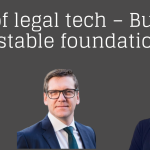We speak with CEO Sean Fitzpatrick; EVP and chief technology officer Jeff Reihl; and vice president of product management, Serena Wellen about the latest updates from LexisNexis, plus bring you the highlights of an earlier chat with Fitzpatrick about what LexisNexis’ alliance with Harvey entails in terms of access and licensing.
On 13 August LexisNexis launched the US customer preview of AI assistant Protégé General AI, enabling users to leverage the latest general purpose AI models within the Lexis+AI workflow and a single, private environment. This announcement followed an earlier, slightly bombshell announcement that LexisNexis and Harvey had entered a strategic alliance, leading to many questions around LexisNexis’ moat and business model moving into the next era, huge excitement around the possibilities of this partnership; and questions around the licensing models.
Speaking in a briefing at ILTACON 2025, LexisNexis’ CEO Sean Fitzpatrick said that Protégé General AI had been created in response to customer requests for safe access to general purpose models. Its responses are generated from open-web sources and it is different from Protégé Legal AI, which gives access to multiple legal-tuned models and legal citations. Users of Lexis+AI are able to choose either option for their work product.
Right now, Protégé General AI lets the user choose models including Claude Sonnet 4 from Anthropic, and GPT-5, GPT-4o and o3 from OpenAI. It can be toggled on or off for users to meet firm policies.
Protégé Legal AI is grounded in legal content; provides up to date content (the consumer grade tools aren’t updated as regularly for case changes etc); and provides a link to citations and transparency as to where it gets its answers from. It leverages Claude 3.7, Claude 4, GPT-4o, GPT-4.1, fine-tuned GPT-4o mini and fine-tuned Mistral, where the best model handles specific use cases. GPT-5 is part of the General AI product but not Legal AI solution.
Speaking at the ILTACON briefing LexisNexis’ CTO Jeff Reihl reminded that LexisNexis has always been model agnostic and started testing GPT-2 in 2020, at a time when the model was not mature enough. The company then began testing GPT-3 as well as evaluating Anthropic and other models, looking at output, use cases and cost.
The wider vision for LexisNexis is that every legal professional has their own personalised, agentic, AI assistant, linked to LexisNexis material and that 15-20% of tasks will be done autonomously through Protégé, which has recently also expanded geographically in availability.
Demonstrating Protégé’s current agentic capability, VP of product management for the US, Canada and UK, Serena Wellen, said that users will be able to guide the agent’s behaviour, observing: “Some agentic work is autonomous and some involves human collaboration. Customers say they need transparency and control.” An orchestrator agent breaks down complex tasks, a legal research agent lets the user define the AI behaviour and a reflection agent strengthens the final response.
Things are moving quickly for LexisNexis, which in June created shockwaves by announcing its strategic alliance with and second major investment in GenAI startup Harvey – a competitor. This kind of alliance is to be commended, given the benefit to the end user, but as with all of these thick and fast announcements, it is important to be clear on what they are, and what they are not.
Speaking to Legal IT Insider in July, Fitzpatrick explained that the Harvey alliance was sparked by one of LexisNexis’ customers, who is also a Harvey customer. “They really like the LexisNexis technology and everything we’re doing, and they also really like Harvey,” said Fitzpatrick. “They thought that if we could bring these two things together, it could create a solution that was even better than the two individual products.”
LexisNexis’ and Harvey’s engineering and product management teams worked together and Fitzpatrick said: “The customer was super happy with the result and we said, ‘Hey, maybe it makes sense to do something else?’ We were really driven together by our customers asking for it.”
He adds: “We’re one of the few places that has that authority, so by taking our authoritative content and marrying it with the Harvey product, it provides a great solution for customers.”
While this sounds good on paper, the alliance also appears, to an extent, to cannibalise LexisNexis’ own product: is this not something that shareholders should be concerned about?
Fitzpatrick said: “We’re always looking to serve our customers in more relevant ways. Harvey has some 300 clients and all of them are LexisNexis customers. So there is an environment where we both live. Our customers want Harvey and LexisNexis. They want both products. They’re complimentary, so it’s an opportunity to expand as opposed to give up market share to a competitor.”
Harvey will have access to LexisNexis’ content and attorneys can feed their own internal work product in too, so it understands their preferences and style. Fitzpatrick said: “There are tens of thousands of workflow activities that attorneys do that need to be automated. We’re working on a couple of those with Harvey – a motion for summary judgment and a motion to dismiss.”
There was confusion when LexisNexis announced the alliance over how the licensing will work. It’s still early days and the product hasn’t launched yet but Fitzpatrick clarified: “Customers still need LexisNexis. With Harvey, you’re going to get a really thin slice of LexisNexis. It’s a really important one, so cases, codes, statutes and Shepherds, really important information, but less than 1% of the information that we have in our repository. We have a huge repository of 130 billion documents and records. We add 2.2 million documents to that system every single day from 50,000 sources. So it’s really hard to maintain and it’s an incredibly large database. It includes things like authored content from some of the leading legal minds. And secondary content, that deep analysis, none of which is included in the Harvey product. So customers absolutely still need Lexis+AI in addition to Harvey. But for that 1% they don’t need Protégé or Lexis+AI and can just use Harvey.”
Users of Harvey will be able to ask a research question around case law or statutes and it will reach to the LexisNexis system, where its AI will analyse the query, answer it, and provide verification of the source.
This evolution and to some extent consolidation of AI models is leading some to question the moat of big research giants such as LexisNexis – will AI be capable of democratising case law and statutes that LexisNexis and Thomson Reuters have built their research empires on?
“We’re adding 2.2 million documents to the system every day. You can’t do that with a large language model,” Fitzpatrick said. “There’s a big issue with relevancy and being up to date and there’s a big issue with collection. That’s a lot of sources. I think it’s unlikely that they are going to be able to capture all that information. To access a court system such as Pacer, you have to pay $0.10 a page. That’s a barrier, and large language models aren’t going to get past that barrier. They could buy the content, but it’s not freely available.
“Large language models are built for efficiency, ours is for both accuracy specific to legal work and performance. We’ve also connected all of our content points: we have over 150bn recorded connections between different pieces of data, which also makes our system more valuable and you get more relevant results. If you look at a case, you can also see the briefs, the associated motions, and important items like complaints and opinions. You’re not going to get even close to that today with any large language model. I don’t know at what point in the future that will happen, but we’re a long, long way away from it.”









